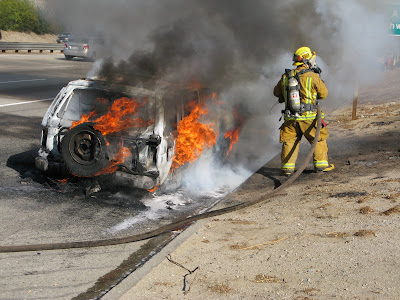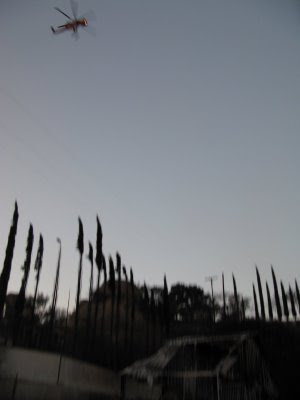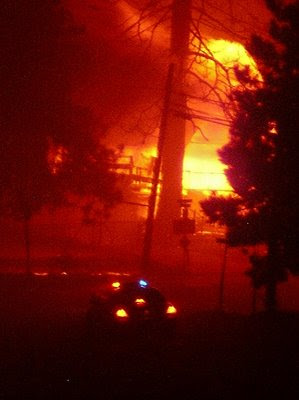
By Guy McCarthy
WATERMAN CANYON - Five years ago, Christmas also fell on a Thursday.
In 2003 the rains came harder.
They pounded down on slopes that had burned two months before in the Old Fire.
The deluge unleashed tons of ash, trees and boulders in Waterman Canyon and neighboring watersheds.
As darkness fell that evening, no one knew exactly how many people were missing.
Frantic rescue efforts were underway. But no one had dealt with chaos like this before.
Some survivors crawled out of Waterman Canyon on their own. Others in Cable Canyon walked through a river of flowing mud and rock to escape.
Some people - including nine children - did not make it out alive.
One man was found pinned under a log, grieving for a daughter ripped from his arms by the raging flood. San Bernardino City Fire Capt. Vinson Gates tried to console him, but the man was beside himself.
It was pitch black that night, Dec. 25 2003, when Mark and Aileen Andrews sat shivering in the back of an ambulance and described the avalanche of debris that roared down Waterman. Still the rains came, pounding in the darkness, forcing rescuers to abandon their efforts until the next morning.
The Andrewses had watched in horror as a grinding, clashing mix of water, mud and boulders tore out bridges on both sides of them on Old Waterman Canyon Road.
They'd found themselves cut off that afternoon, but low-lying fog and dark clouds made it seem like dusk in the deep canyon above north San Bernardino.
A thundering torrent was still churning 15 feet above the creek bed, four to five feet wide on the roadway in places. In the eerie aftermath of one of the slides, Aileen Andrews said she could hear voices.
"There were people standing in their yards, worried their houses were going to come down," she said. "One of the houses by the river had four big trees that went completely through . . . Some people chose to stay, but we didn't want to. We left about 15 people down there."

Rescues were underway elsewhere, but the Andrewses and others caught between two washed-out bridges were trapped.
Mark Andrews, 45, and Aileen Andrews, 40, of Crestline decided to save themselves. They gathered their courage and climbed the steep, slick, flood-washed slopes for nearly an hour before they came to Highway 18.
"I was climbing literally on my knees," Aileen Andrews said. "We were slipping and sliding. We were about to turn back when the fog lifted and we could see the 18. We made a beeline to the highway and a fire truck picked us up.
"We're grateful to be alive, definitely," she said. "I wasn't on my own though. I give it all to God."
The Andrewses were still in soaked, muddy clothing that evening as they spoke to a group of fire commanders and search-and-rescue volunteers near the top of Waterman Canyon.
"There were people still in there," Mark Andrews told the officials, who pored over a map of the canyon as the pair spoke. "They were by the houses, between those two bridges."
Minutes later, they huddled in the back of the ambulance, parked outside a hastily set-up command center.
Paramedic Lisa Comnick wrapped them in thermal blankets, cranked the ambulance heat on high, and fed them candy canes and salted peanuts still in the shell.
Other ambulances nearby were stuck in mud and debris from continuing slides. Comnick said the Red Cross was going to bring dry clothes and more blankets.
It was unclear at that point whether the Andrewses would be evacuated.
"Our son, Joshua, hasn't even opened his Christmas presents yet," Mark Andrews said. The 11-year-old was staying with a neighbor in Crestline.
The Andrewses said they got trapped on Old Waterman Canyon Road after they tried to avoid slide debris on Highway 18.
"My wife works at San Bernardino Community Hospital and I came down the 18 to pick her up," Mark Andrews said. "The highway was a mess, so we came back up the side road."
"That was a big mistake," Aileen Andrews said. "We saw rocks and water on the road, then it was like a freight train. It was rocks, boulders, trees, whole trees getting knocked down. We couldn't get through."
"We tried to turn around, but the bridge was washing out," she said. "We got out of the car to get to higher ground."
They left their four-wheel-drive Toyota Rav 4 on the shoulder and tried to get their bearings.
"The one bridge was there one minute and we looked back and it was gone," Mark Andrews said. "Then the other was gone."
About 100 yards ahead, an empty car stood on the road, its lights on, engine still running. No one came back for it in the minutes that passed before the Andrewses started trying to climb up to the highway.
"If anyone was standing outside that car when the flood came through
. . . " Mark Andrews said. "They were swept away, gone. Nobody came back to that car."
Two hundred yards behind, another car stood battered and dented in the road, its windows smashed and the hood and trunk lids open. The Andrewses spoke briefly with residents standing in their yards before they left, including a man who lived in one of the flood-damaged homes.
"He was on a cell phone and said, 'I can't come for Christmas because I got a bunch of trees in my living room. And they aren't Christmas trees,' " Mark Andrews said.
The Andrewses' home in Crestline was less than a mile from homes that burned in the Old Fire. They said their escape from fire-induced avalanche and flood was more good fortune.
"I was scared, but I was confident we'd get out too," Aileen Andrews said. "We felt trapped. We had to do something."

-30-
Sixteen people lost their lives that day. It took rescuers many days to uncover and retrieve all the bodies. The last victim from Waterman Canyon was found four months later, 15 miles downstream. Another survivors' story from Christmas 2003 is here.
Note: This account is based on an article originally reported and written for Dec. 26 2003 editions of The Sun newspaper in San Bernardino.
All photos Dec. 26 2003 by Guy McCarthy.












































